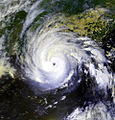TIROS-N
 | |||||||||||||||||||||||||||||
| Mission type | Weather | ||||||||||||||||||||||||||||
|---|---|---|---|---|---|---|---|---|---|---|---|---|---|---|---|---|---|---|---|---|---|---|---|---|---|---|---|---|---|
| Operator | NOAA | ||||||||||||||||||||||||||||
| COSPAR ID | 1978-096A | ||||||||||||||||||||||||||||
| SATCAT no. | 11060 | ||||||||||||||||||||||||||||
| Mission duration | 2 years (planned) 868 days (achieved) | ||||||||||||||||||||||||||||
| Spacecraft properties | |||||||||||||||||||||||||||||
| Spacecraft | TIROS-N | ||||||||||||||||||||||||||||
| Launch mass | 734 kg (1,618 lb) | ||||||||||||||||||||||||||||
| Start of mission | |||||||||||||||||||||||||||||
| Launch date | 13 October 1978, 11:23:00 UTC[1] | ||||||||||||||||||||||||||||
| Rocket | Atlas F | ||||||||||||||||||||||||||||
| Launch site | Vandenberg Air Force Base | ||||||||||||||||||||||||||||
| End of mission | |||||||||||||||||||||||||||||
| Deactivated | 27 February 1981 | ||||||||||||||||||||||||||||
| Orbital parameters | |||||||||||||||||||||||||||||
| Reference system | Geocentric orbit | ||||||||||||||||||||||||||||
| Regime | Sun-synchronous orbit | ||||||||||||||||||||||||||||
| Perigee altitude | 829 km (515 mi) | ||||||||||||||||||||||||||||
| Apogee altitude | 845 km (525 mi) | ||||||||||||||||||||||||||||
| Inclination | 98.70° | ||||||||||||||||||||||||||||
| Period | 101.70 minutes | ||||||||||||||||||||||||||||
| |||||||||||||||||||||||||||||
TIROS-N satellite is the first of the TIROS-N series. It is a weather satellite launched on 13 October 1978.[2] It was designed to become operational during 2 years. Its mass is 734 kilograms.[2] Its perigee to Earth is 829 kilometers. Its apogee is 845 kilometers away from Earth. Its inclination is 98.70°. It was managed by the U.S. National Oceanic and Atmospheric Administration (NOAA); designed and launched by NASA. The spacecraft was 3-axis stabilized.[2] TIROS-N was operated for 868 days until deactivated by NOAA on 27 February 1981.[3]
Gallery of cyclones captured by this satellite
- Typhoon Tip (14 October 1979) 2 days after reaching peak intensity.
References
- ^ "Display: TIROS-N 1978-096A". nssdca.gsfc.nasa.gov. NASA. 14 May 2020. Retrieved 27 December 2020.
 This article incorporates text from this source, which is in the public domain.
This article incorporates text from this source, which is in the public domain.
- ^ a b c "Tiros N". Archived from the original on 24 June 2014. Retrieved 10 May 2014.
- ^ "TIROS-N/NOAA Program - 1978-1986". NASA. Archived from the original on 9 December 2014. Retrieved 10 May 2014.
 This article incorporates text from this source, which is in the public domain.
This article incorporates text from this source, which is in the public domain.
External links







